Antibody data
- Antibody Data
- Antigen structure
- References [1]
- Comments [0]
- Validations
- Immunohistochemistry [2]
- Flow cytometry [2]
- Other assay [2]
Submit
Validation data
Reference
Comment
Report error
- Product number
- PA5-78968 - Provider product page

- Provider
- Invitrogen Antibodies
- Product name
- DC-SIGN (CD209) Polyclonal Antibody
- Antibody type
- Polyclonal
- Antigen
- Synthetic peptide
- Description
- Reconstitute with 0.2 mL of distilled water to yield a concentration of 500 µg/mL. Positive Control - WB: human HepG2 whole cell. IHC: human intestinal cancer tissue, human placenta tissue. Flow: THP-1 cell.
- Reactivity
- Human
- Host
- Rabbit
- Isotype
- IgG
- Vial size
- 100 μg
- Concentration
- 500 μg/mL
- Storage
- -20°C
Submitted references The use of patient-derived breast tissue explants to study macrophage polarization and the effects of environmental chemical exposure.
Gregory KJ, Morin SM, Kubosiak A, Ser-Dolansky J, Schalet BJ, Jerry DJ, Schneider SS
Immunology and cell biology 2020 Nov;98(10):883-896
Immunology and cell biology 2020 Nov;98(10):883-896
No comments: Submit comment
Supportive validation
- Submitted by
- Invitrogen Antibodies (provider)
- Main image
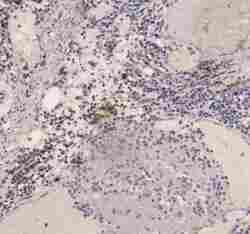
- Experimental details
- Immunohistochemistry analysis of DC-SIGN (CD209) on paraffin-embedded human intestinal cancer tissue. Antigen retrieval was performed using citrate buffer (pH6, epitope retrieval solution) for 20 mins. Sample was blocked using 10% goat serum, incubated with DC-SIGN (CD209) polyclonal antibody (Product# PA5-78968) with a dilution of 1 µg/mL (overnight at 4°C), and followed by biotinylated goat anti-rabbit IgG (30 minutes at 37°C). Development was performed using Streptavidin-Biotin-Complex (SABC) with DAB chromogen method.
- Submitted by
- Invitrogen Antibodies (provider)
- Main image
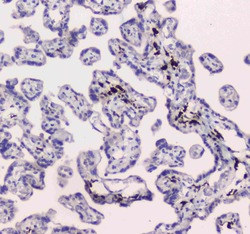
- Experimental details
- Immunohistochemistry analysis of DC-SIGN (CD209) on paraffin-embedded human placenta tissue. Antigen retrieval was performed using citrate buffer (pH6, epitope retrieval solution) for 20 mins. Sample was blocked using 10% goat serum, incubated with DC-SIGN (CD209) polyclonal antibody (Product# PA5-78968) with a dilution of 1 µg/mL (overnight at 4°C), and followed by biotinylated goat anti-rabbit IgG (30 minutes at 37°C). Development was performed using Streptavidin-Biotin-Complex (SABC) with DAB chromogen method.
Supportive validation
- Submitted by
- Invitrogen Antibodies (provider)
- Main image
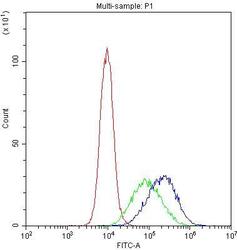
- Experimental details
- Flow Cytometry of DC-SIGN (CD209) in THP-1 cells (blue line), isotype control rabbit IgG (green line) and unlabeled (red line). Samples were blocked with 10% goat serum, incubated with DC-SIGN (CD209) Polyclonal Antibody (Product # PA5-78968) at a dilution of 1 μg (per 1x10^6 cells), followed by DyLight®488 conjugated goat anti-rabbit IgG (for 30 minutes at 20°C) using 5-10 μg (per 1x10^6 cells) dilution.
- Submitted by
- Invitrogen Antibodies (provider)
- Main image
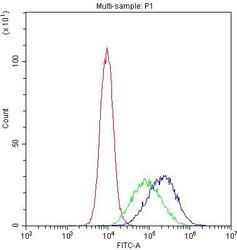
- Experimental details
- Flow Cytometry of DC-SIGN (CD209) in THP-1 cells (blue line), isotype control rabbit IgG (green line) and unlabeled (red line). Samples were blocked with 10% goat serum, incubated with DC-SIGN (CD209) Polyclonal Antibody (Product # PA5-78968) at a dilution of 1 μg (per 1x10^6 cells), followed by DyLight®488 conjugated goat anti-rabbit IgG (for 30 minutes at 20°C) using 5-10 μg (per 1x10^6 cells) dilution.
Supportive validation
- Submitted by
- Invitrogen Antibodies (provider)
- Main image
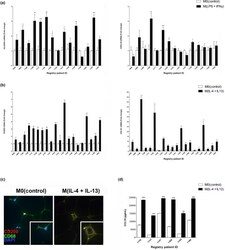
- Experimental details
- Figure 1 Normal breast PDEs can be polarized toward M(IFNgamma + LPS) or M(IL-4 + IL-13). RNA was harvested from cytokine-exposed PDEs and mRNA levels of (a) HLA-DRA and CXCL10 (15 patients) or (b) CD209 and CCL18 (20 patients) were analyzed by real-time PCR. All real-time PCR results are from two separate experiments (performed technical duplicate) and results were normalized to amplification of CD68 (macrophage marker). (c) PDE sections were subjected to fluorescent immunohistochemical analysis, dual stained for CD68 and CD209 and merged images were captured at 4000x. Representative pictures are displayed for tissues from each treatment group. (d) Supernatant was collected from PDEs (six patients) treated with IL-4 + IL-13 cytokines and CCL18 protein secretion was measured by ELISA performed in biological triplicate and technical duplicate M0(control) PDEs. Data within each bar represent triplicate samples isolated from individual patients, are presented as mean +- s.e.m. and are expressed as fold change with respect to M0(control) PDEs. * P < 0.05, ** P < 0.01, *** P < 0.001 (significantly different from indicated data set using a Student's t -test). IFN, interferon; IL, interleukin; LPS, lipopolysaccharide; mRNA, messenger RNA; PDE, patient-derived explant.
- Submitted by
- Invitrogen Antibodies (provider)
- Main image
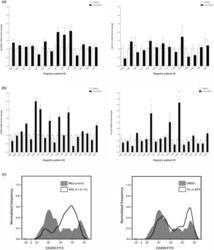
- Experimental details
- Figure 2 The xenoestrogen, BP3, can increase the expression of M2a markers in a subset of PDEs. RNA was harvested from PDEs treated with either vehicle (DMSO) or 30 mu m BP3 and mRNA levels of (a) HLA-DRA and CXL10 (14 patients) or (b) CD209 and CCL18 (19 patients) were analyzed by real-time PCR. All real-time PCR results are from two separate experiments (performed in technical duplicate) and results were normalized to amplification of CD68 (macrophage marker). Data within each bar represent triplicate samples isolated from individual patients, are presented as mean +- s.e.m. and are expressed as fold change with respect to DMSO treated M0(control) PDEs. * P < 0.05, ** P < 0.01, *** P < 0.001 (significantly different from indicated data set using a Student's t -test). (c) Cell surface protein expression of CD209 in treated primary human macrophages was measured by flow cytometry. BP3, benzophenone-3; DMSO, dimethyl sulfoxide; FITC, fluorescein isothiocyanate; mRNA, messenger RNA; PDE, patient-derived explant.
 Explore
Explore Validate
Validate Learn
Learn Western blot
Western blot Immunohistochemistry
Immunohistochemistry